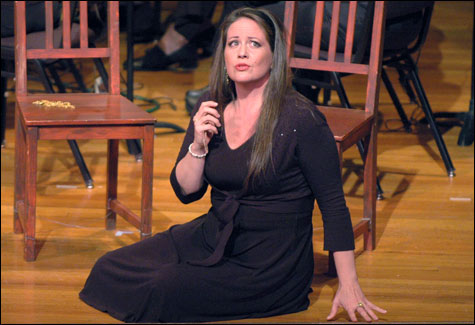Bach at Emmanuel, Boston Baroque’s Cosí fan tutte, Kiri Te Kanawa’s farewell to Boston
By LLOYD SCHWARTZ | October 16, 2007

COSÍ FAN TUTTE: The biggest hand went to Fiordiligi Lauren Skuce, who was strong and
uninhibited, though not much seemed felt. |
Craig Smith’s Emmanuel Music began its season with Bach, the composer it’s best known for. But Bach’s Der Kunst der Fuge (“The Art of the Fugue”) is better known for not being played at all. Bach left his last work — a 14-part exploration of and testament to the fundamental element of counterpoint in his compositional practice — unfinished, left it without even an indication of what instrument (or instruments) it was written for. It’s been recorded on harpsichord, piano, and organ; by string quartets; by chamber orchestras — but it’s seldom done live. It’s just too difficult. Emmanuel solved this problem by having it played by 13 distinguished pianists, all of whom donated their services to benefit Emmanuel Music. The honor roll, in order of appearance: Sergey Schepkin (who played both the quiet first fugue and the staggeringly complex last fugue, which begins with a return of the hushed opening theme), Robert Merfeld, Sally Pinkas, John Harbison, Bruce Brubaker, Michael Lewin, Katherine Chi, Judith Gordon, Yehudi Wyner, Ya-Fei Chuang, Robert Levin, Leslie Amper, and Randall Hodgkinson.Given the nature of the work itself, and Bach’s architectonic mastery, the evening was an intense and complex experience, moving and meditative — but also, given Bach’s range of effect and affect, enormously enjoyable, even, in parts, fun. Each pianist was well suited to the section he or she chose or was assigned: Schepkin’s poetic delicacy; Chi’s combination of clarity (you could hear every line in one of the most challenging of all the fugues and canons), elegance, and solemnity; Harbison’s textured inwardness; Gordon’s intellectual and physical energy; Wyner’s whirlwind rhythmic passion; Chuang’s lightness of touch; Levin’s dramatic urgency.
Yet despite all the individual, sometimes quirky differences, what emerged was mysteriously unified. For nearly two hours, the Emmanuel audience listened rapt as Bach kept pushing the limits of what he could do, of his own understanding. And when Schepkin finally broke off where Bach did, mid phrase, you could almost hear a collective gasp.
Music director Martin Pearlman assembled a cast of fearless young singers for Boston Baroque’s latest version of Mozart’s Cosí fan tutte, and stage director Ned Canty got them to throw themselves into their parts. The audience stood and cheered at the end of a long, uncut evening that offered some three hours of music.
A good performance of Cosí should be at the same time hilarious and heartbreaking. With stabbing key changes and piercing harmonies, Mozart darkens — and humanizes — Lorenzo da Ponte’s devastating satirical farce about two young men who are convinced of the absolute fidelity of their lovers before being disabused of their illusions.
 Related
Related:
From Knoxville to Swan Lake and back, World music, Movie music, More 
- From Knoxville to Swan Lake and back
As our most prestigious classical-music institution, the Boston Symphony Orchestra ought to be every year’s headliner, and once again, under the adventuresome direction of James Levine, it is.
- World music
There’s more to Boston’s classical music scene than the Boston Symphony Orchestra.
- Movie music
Classical music in 2008 Boston did not get off to a brilliant start.
- In the swim
My head’s swimming.
- Ye gods!
Much beautiful music turns up in the 18th-century operatic form that’s probably most alien to a modern audience.
- Odds and endings
The classical-music season is winding up without winding down.
- Boston feasts
The Boston Symphony Orchestra, Celebrity Series, Emmanuel Music, Boston Early Music Festival, and more.
- Transfigured nights
James Levine and the BSO resumed their Beethoven/Schoenberg series with superb performances of two pieces at the opposite ends of the Schoenberg spectrum.
- Beloved of God
Johannes Chrisostomas Wolfgang Gottlieb (Amadé) Mozart was born 250 years ago last Friday, January 27.
- More than Mozart
One of the spring’s most exciting prospects is the premiere of John Harbison’s But Mary Stood: Sacred Symphonies for Chorus and Instruments.
- Opera, opera, opera
Every performance at Santa Fe was packed, and few subscribers left unhappy.
- Less

 Topics
Topics:
Classical
, Entertainment, Lorenzo da Ponte, Robert Levin, More  , Entertainment, Lorenzo da Ponte, Robert Levin, Hugh Russell, Jennifer Holloway, Kevin Burdette, Music, Wolfgang Amadeus Mozart, Classical Music, Orchestral Music, Less
, Entertainment, Lorenzo da Ponte, Robert Levin, Hugh Russell, Jennifer Holloway, Kevin Burdette, Music, Wolfgang Amadeus Mozart, Classical Music, Orchestral Music, Less 